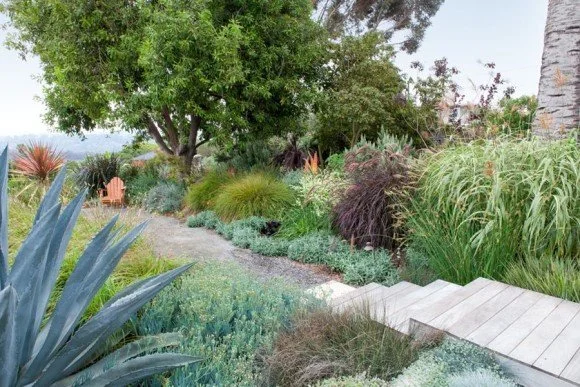Creating A Drought Tolerant Landscape
Using Native plants can greatly reduce the need for daily irrigation
Using Native Plants will greatly reduce daily watering needs
Evaluate your site.
Consider environmental factors such as light, soil, temperature, and humidity to determine what plants would be suitable for your landscape. Observe how the light falls in different seasons. There will be different conditions occurring in different parts of the yard, with dry, wetter, and transitional zones.
Draw up a plan.
Look to online and local sources for inspiration and create a rough sketch. For a more elaborate plan, or for difficult sites such as a slope, you may want to hire a landscape design professional.
Amend soil.
Depending on what you are planting, you may want to amend your soil. Amended soil retains moisture better and captures rainwater, while poor compacted soil allows water to run off the surface. Use organic matter such as compost, decomposed leaves, manure, or a combination. You may wish to add perlite, vermiculite, or lava rock (to help with aeration at the root zone) if planting cactus or succulents, but best to plant these in a mounded area.
Choose drought-resistant or drought-tolerant plants.
Select plants that require less water such as natives, sedums, succulents, and ornamental grasses. Natives have an added bonus of attracting local pollinators and birds to your garden. Plants with gray or silver foliage such as lamb’s ear, Russian sage, lavender, and santolina are more drought tolerant. Non-native ornamental plants from Australia, South Africa, and the Mediterranean use less water. Make sure non-natives are not invasive in your area. See more drought resistant plants.
*Note: All plants need to establish for at least two years before they will start to need less water; trees and large shrubs will take longer.
Group plants with similar water needs.
Assess the water needs of each variety and group plants together that have similar needs. This will help conserve water, and plants will be healthier because they are less likely to be over or underwatered.
Place plants closer together.
Beds that are more densely planted shade the soil, which reduces water evaporation. This also helps to suppress weeds, which can take moisture out of the soil.
Plant trees.
Create a shade canopy with trees that will cool your yard and home, act as a windbreak, and reduce water evaporation.
WATER SAVING IDEAS
There are many ways to save on your water bill. Here’s how:
Reduce or eliminate your lawn.
Green turf lawns take a lot of water and other resources to maintain. You don’t have to get rid of all of your lawn, but you can create drought-resistant garden beds in part of your yard. Some turf grasses require less water, fertilizer, and mowing. Groundcovers such as dead nettle, creeping thyme, and sedums can be substituted for a traditional lawn to control runoff and reduce water evaporation. See more eco-friendly lawn alternatives.
Use native plants.
Varieties that grow endemically to your area are adapted to your climate and growing conditions. These plants will need little supplemental water once established. Natives require little or no fertilizer and are more resistant to pests and diseases. Learn more about how to use native plants in your landscape.
Add permeable hardscape and outdoor rooms.
Create pathways or transition areas with permeable pavers or gravel to allow water to percolate into the ground rather than running off. Add a patio, deck, and other outdoor living spaces or garden rooms to reduce the amount of planted areas.
Rain barrels or cisterns collect water from gutter downspouts that can be used to water garden beds. Photo by: JuneJ / Shutterstock.
Plant a curbside strip.
The area between your curb and sidewalk is sometimes referred to as a “hell strip” for its reputation as a hot, inhospitable place. Creating a dry garden with drought-tolerant plants can help stem water loss, reduce maintenance, and control soil erosion.
Collect rainwater.
To conserve water, install rain barrels or a cistern to collect water from gutter downspouts that can be used later on to water garden beds.
Create a rain garden.
Add one or more rain gardens around your yard to capture water, reduce runoff, and conserve water. Find out more about how to create a rain garden.
Construct a water-efficient slope.
Add tiers to slopes to help stem erosion and control rainwater runoff. Place the most drought-resistant plants at the top of a slope where water drains more quickly, with plants that like the most water at the bottom, where water will collect after it rains. Find more on hillside landscaping.
MAINTENANCE
Water wisely.
The way you water your plants can reduce your water usage.
Use drip irrigation or soaker hoses in beds to deliver water to plant roots, which is more efficient and reduces evaporation. You can install irrigation systems yourself or hire a professional. Learn more about irrigation systems.
For containers, use a watering wand to direct water around the base of plants rather than spraying from overhead.
Water early or late in the day when temperatures are cooler to reduce evaporation.
Irrigate plants more deeply and less frequently, which will encourage roots to grow deeper into the soil, requiring less water.
Don’t overwater plants that are adapted to dry conditions, as they can develop root rot or other problems.
For more: How to Water Your Summer Garden
Mulch.
Add a layer of mulch around plants to retain moisture, cool the soil, and suppress weeds. Organic mulch includes compost, bark, or wood chips. Use gravel as a mulch in rock gardens or hell strips. Plant ground covers as a living mulch.
Weed.
Keep out thirsty weeds that will compete with garden plants for water.
reference: Garden Magazine July 2024


